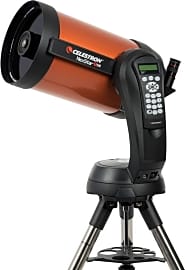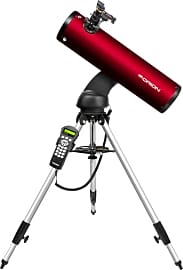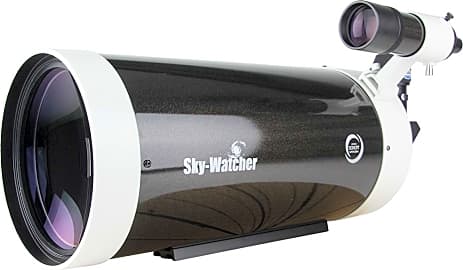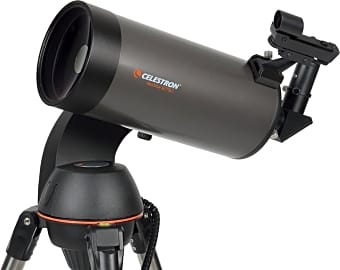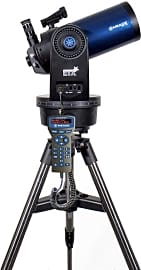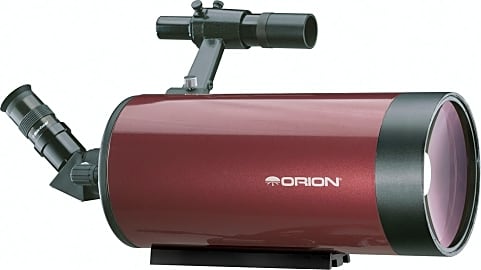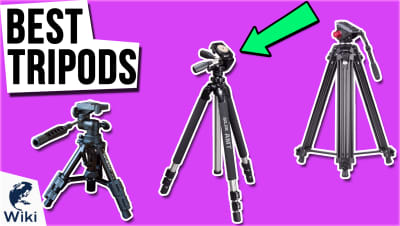The 7 Best Catadioptric Telescopes

This wiki has been updated 34 times since it was first published in October of 2016. Catadioptric telescopes combine many of the best features of refractors and reflectors into one package, with only a few of their drawbacks. They allow the performance of a large aperture, long focal length 'scope to be folded into reasonably lightweight and transportable housings that are ideal for stargazers on the go, as they're often very easy to set up and calibrate. When users buy our independently chosen editorial picks, we may earn commissions to help fund the Wiki.
Editor's Notes
June 10, 2021:
Some of our high-end choices from last round are unavailable, but most of them are readily replaced with just slightly smaller models that perform nearly as well. One that is still easy to get your hands on and very highly recommended is the Celestron CPC 1100 GPS SCT, which is almost identical to our previous top pick. Both beginner and intermediate users will appreciate the Orion StarSeeker IV 130mm due to its high performance and relatively moderate price. On the other hand, you can get great image quality from the even less expensive Celestron NexStar 127SLT as long as you know what you're doing.
February 06, 2020:
Reviewing our previous ranking, we saw that a number of offerings from Meade and Celestron had begun suffering availability issues as a result of some new models or of some tweaks to the current lineup, leading us to send a few of those away. We also got rid of the Celestron NexStar Evolution 9.25, which is a high-end offering from the company, but one that had a hard time achieving and maintaining proper alignment settings.
Among the new models on our list, we wanted to include the SkyWatcher S11540, as this is a very capable model from a company that often lags behind the likes of Orion and Celestron in marketing and name recognition. It's by no means perfect, as its optical tubing can warp as it expands or contracts in environments where the temperature has shifted (moving from inside to outside on a cold night, for example), but once adjusted, provides excellent images.
Why Catadioptric Telescopes Are King
In an attempt to simplify things, we’re going to look at the three main types of telescopes you’re liable to find for sale, and what important differences exist among them.
If you’re in the market for a telescope, you’ve probably come across a litany of terms that can become very confusing very quickly. In an attempt to simplify things, we’re going to look at the three main types of telescopes you’re liable to find for sale, and what important differences exist among them. The three most commonly sold types of telescopes are refracting, reflecting, and catadioptric. There are subdivisions of this type, as well, but we’ll save that for a little later.
To begin, the refracting telescope relies on lenses to achieve its clarity and magnification. This design works in a similar way as a set of binoculars or even a camera lens. The advantage of this design is durability and relatively low maintenance, as the enclosed tube in which the glass elements live is usually pretty rugged and easily keeps out dust and other debris. The problem with these is that ground glass of a high enough quality to achieve a clear image of celestial objects is very expensive, so most of the refracting telescopes on the market have a smaller opening at the far end, a part of the telescope often called the aperture or light collecting area. Another downside to refractors is the fact that the eyepiece has to be situated in a direct line from the aperture, so either the tripod on which the telescope is mounted needs to be exceedingly tall, or you’re going to have to stoop somewhat uncomfortably to look through it.
Most of the problems with refracting telescopes are solved with a reflecting telescope, which uses comparably inexpensive mirrors in the place of glass elements, so the light collecting area if often much bigger. They can also redirect their collected light in almost any direction, usually through an eyepiece situated at a 90-degree angle from the light path, making it very easy to look into.
That’s not to say that reflecting telescopes don’t have problems of their own. Their open-tube design means that dust will slowly settle on the mirrors, even if you keep the unit covered. That will necessitate a more intensive maintenance process, and it gives you plenty of opportunity to accidentally scratch or otherwise damage some part of the mechanism.
The catadioptric telescope marries the best of each design while leaving behind the aspects that make either less than ideal. It utilizes both lenses and mirrors to gather and direct light, so it can afford to have a large light collecting area without becoming unnecessarily expensive. It also has a fully enclosed tube to keep maintenance at a minimum, and its light can be directed through an eyepiece at a variety of angles. What’s most impressive, though, is that the combination of elements actually results in a clearer image than you get with either of the other two types, making the catadioptric telescope ideal for viewing or even photographing distant celestial objects.
The Different Types Of Catadioptric Telescope
Now that you understand why there’s no substitute for a good Catadioptric telescope, it’s important that you get a sense of the different kinds available to you, so you can choose the best one for your needs.
Its catadioptric varieties combine this mirror pairing with one or more lenses to amplify, clarify, or otherwise improve the light signal.
Most catadioptric telescopes are also Cassegrain telescopes, a name taken from the man named Laurent Cassegrain, whose early design of the instrument first appeared in Journal des Sçavans in 1672. The Cassegrain design utilizes both a convex and concave mirror to achieve its reflected affect. Its catadioptric varieties combine this mirror pairing with one or more lenses to amplify, clarify, or otherwise improve the light signal.
Catadioptric Cassegrain varieties include the Schmidt-, Muskatov-, Argunov-, and Klevstov-Cassegrain telescopes. Each type uses a slightly different means of correcting for the way the telescopes’ internal mirrors bend and distort the light they collect, with the Schmidt and Muskatove designs being the most popular for their ease of calibration and use. The Argunov and Klevstov types are by no means inferior for their imaging, but they might not be suitable for anyone but professionals looking for specific types of celestial bodies.
Other Important Features To Look For In Your Telescope
Once you’ve decided on a type of telescope to buy, there are plenty of other features for you to consider, many of which can make deciding between two or three potential models much easier.
Nothing will spoil your viewing or astrophotography experience more readily than an unstable surface.
The most basic question to ask about any telescope is whether it comes with a tripod, and whether that tripod is any good. Nothing will spoil your viewing or astrophotography experience more readily than an unstable surface. If you own a decent pair of binoculars, take them outside at night and try to keep a large, bright star in your field of view. Unless you’re a trained sniper, this might prove rather difficult. A strong, stable tripod will make even a slightly inferior telescope outperform a more expensive model on a weak set of sticks.
The next most important feature of any telescope is its ability to track celestial objects. Many models come with control units that can act as remotes into which you can program the coordinates of a certain body, and it will allow the telescope, in conjunction with its tripod, to move automatically across the sky at the same rate as the object you’re tracking, always keeping it in view. If you have a camera attached to your telescope and you’re running long exposures to increase the clarity of your image, you’ll need this feature. It’s also really convenient if you fix your scope on a planet, then run inside to get the kids, and you don’t have to find it again once they join you.
Finally, consider portability. You might be willing to sacrifice a little bit of magnification or image quality to know that you can easily pack up, transport, and setup your telescope at a new location. This is particularly important if you live in an area with a lot of light pollution, and you want to be able to break down the setup you had for spying on your neighbors and take it out to the woods to watch a meteor shower.


